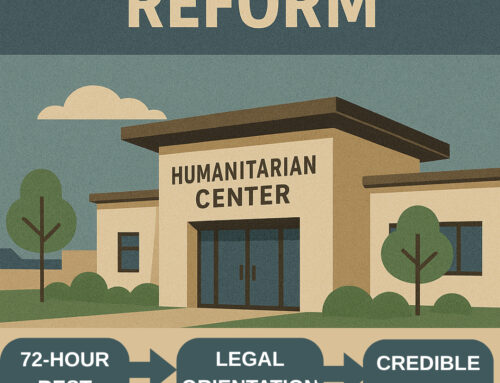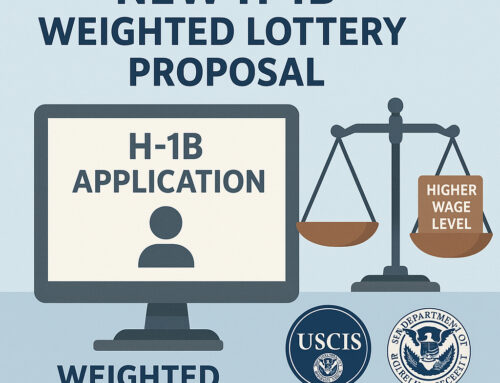Facing a Physician Shortage? International Medical Graduates Can Help Solve Your Staffing Challenges
Our client, a triple board-certified doctor, researcher, author, and teacher is a true “Renaissance Man” in medicine. His exceptional talents brought him to the U.S. on an O-1 Extraordinary Ability Visa, where he quickly became a respected leader and trusted physician at the hospital where he practices in Georgia. Recognizing his invaluable contributions, his employer was committed to securing his permanent role within their healthcare organization.
That’s where we came in. Drawing on our wisdom, expertise, and strategic foresight, we guided him through the complex EB-1A green card process. Recently, we had the privilege of celebrating his official green card approval by the U.S. Citizenship and Immigration Services (USCIS). It’s a milestone that cements his future in the U.S.
His journey exemplifies how talented and driven international medical graduates (IMGs) can build thriving careers and make a lasting impact on American healthcare. Alongside many other highly qualified IMGs, our client contributes significantly to addressing the persistent physician shortage in the U.S., representing a remarkable opportunity for forward-thinking healthcare organizations to build a diverse, highly skilled workforce by welcoming the talents of international medical graduates.
Why Is the Physician Shortage a Problem and What’s Causing It?
The U.S. is facing a projected shortage of up to 86,000 physicians by 2036, according to the Association of American Medical Colleges (AAMC).
The same report points to the aging U.S. and physician populations for the alarming shortage projections.
For one, an aging population demands more care for their health, further stressing the need for physicians, especially as the population of elders is dramatically increasing. The number of individuals aged 65 and older is projected to increase by approximately 34%, while those aged 75 and older are expected to grow by about 55%.
At the same time, a critical mass of the physician workforce is nearing or at retirement age. Clinical physicians aged 65+ already make up 20% of the workforce, while physicians aged 55-64 represent 22% of the workforce.
Coupled with COVID-induced burnout, where 117,000 physicians left the profession between the first quarter of 2020 and the fourth quarter of 2021, this isn’t just a future concern—it’s a pressing issue today, especially in underserved and rural communities.
The Health Resources & Services Administration estimates that upwards of 77 million people already live in a primary-care health professional shortage area (HPSA). In addition, the AAMC predicts that 202,800 more physicians would be needed if people in underserved communities had the same level of access to healthcare as those in well-served areas.
Physician Shortage by Specialty
According to the latest projections from the Health Resources & Services Administration, nearly all physician specialties 31 of the 35 will experience a shortage by 2037.
Vascular surgery (64%), thoracic surgery (66%), ophthalmology (68%), other specialists (68%), and family medicine (73%) are projected to have the lowest supply adequacy in 2037. Emergency medicine (116%), critical care and pulmonology medicine (110%), endocrinology (102%), and neonatology (100%) will have the highest.
U.S Medical School Enrollment Won’t Close the Gap
The natural place to focus attention to close the physical shortage gap is to train new U.S. physician talent.
But that alone isn’t enough.
Even with increased demand among new graduates to obtain medical degrees, there are a limited number of medical school seats and post-graduate internship and residency training programs.
Dr. Stephen Frankel, a pulmonologist and the executive vice president of clinical affairs at National Jewish Health in Denver, expressed his concern in an interview with TIME Magazine.
He said, “Training new physicians is a time-consuming and expensive process, and there are only so many medical schools in the U.S. with so many seats.”
This is precisely why international medical graduates, who have already undergone rigorous education and training, represent such an invaluable asset to the U.S. healthcare system. They are ready to contribute, want to call the U.S. home, and bring a wealth of global expertise to American hospitals and medical practices.
Welcoming International Medical Graduates Bridges the Physician Shortage Gap
As hospitals and medical practices grapple with the challenge of finding skilled physicians to fill critical roles in their healthcare organizations, many turn to highly trained physicians from other countries.
According to the Migration Policy Institute, 26% of physicians in the U.S. are international medical graduates (IMGs) who obtained visas and required licenses to practice in the U.S., many serving in rural and underserved community hospitals and medical practices where the need is the greatest.
No doubt, the immigration process for both healthcare organizations and physicians isn’t easy, but when approached as a long-term workforce strategy, it can substantially help your hospital or medical practice solve physician shortages faster.
Several states, including Florida, Iowa, Idaho, Illinois, Louisiana, Massachusetts, Tennessee, Virginia, and Wisconsin, have enacted legislation allowing qualified IMGs to obtain licenses without traditional U.S. residency training based on their international credentials, clinical experience, and certifications from the Educational Commission on Foreign Medical Graduates (ECFMG).
The strategic advantages for your hospital or medical practice of securing IMGs are many:
- Expand access to care in underserved areas.
- Increase cultural competence and diversity. Many IMGs speak multiple languages and understand care delivery across cultures.
- Reduce physician shortages and achieve your workforce goals.
“With the ongoing physician shortage, it’s crucial to explore foreign talent as part of the solution,” says Garvish Immigration Law Group Managing Attorney Nadia Deans Kalata. “Hospitals that embrace these professionals not only fill critical staffing gaps but also gain dedicated employees who are highly qualified and eager to contribute to quality patient care.”
Your Roadmap to Hiring International Physicians
Through our dedicated healthcare immigration practice, we provide comprehensive legal guidance, consultation, and execution to help medical practices and hospitals establish a successful long-term immigration workforce strategy.
Most IMGs are in the U.S. completing Residency and Fellowship training in either J-1 or H-1B status. For J-1 visa holders, they will need a waiver of the two year home residence requirement to work in the U.S. Some J-1s may opt for an O-1 visa option if they do not have a job offer that qualifies for a waiver. H-1B holders may simply extend their stay and change employers and remain in H-1B status by filing a new petition. At Garvish, we can handle every scenario and here are some tips to make the process a bit smooth focusing on J-1 IMG hires:
1. Start Early – At Least One Year in Advance
Starting earlier than you think ensures the visa and waiver processes are completed in time. Waiting too long can result in the physician falling out of legal status.
2. Secure a Contract Before Residency or Fellowship Ends
A well-timed contract allows employers to initiate the J-1 waiver process early, setting both the physician and the healthcare organization up for success.
3. Choose the Right J-1 Waiver Path
Physicians on a J-1 visa must complete a two-year home residency requirement unless they obtain a waiver. Common waiver programs include:
- Conrad 30 Program (State-based waivers for underserved areas)
- HHS Waiver (For physicians working in Health Professional Shortage Areas)
- Multi-state/regional organizations – such as SCRC- Waiver (For specialists cases)
4. Obtain State and Federal Approvals
Depending on the waiver program used, employers must apply for a waiver recommendation letter from the HHS, the organization or the state where the physician will work. The waiver application is then sent to the Department of State (DOS) and U.S. Citizenship and Immigration Services (USCIS) for final approval. These steps often happen simultaneously to speed up the process.
5. File the H-1B Petition for Work Authorization
Once the J-1 waiver is approved, the employer must file an H-1B petition with USCIS. The H-1B allows the physician to legally work in the U.S. Physicians on a waiver must commit to working in an underserved area for at least three years.
6. Ensure You as the Employer Qualify for the Program
Qualified employers must:
- Accept Medicaid and Medicare in most cases.
- Agree not to turn away patients based on financial need.
- Meet other government requirements for hiring foreign medical professionals.
7. Monitor Government Processing Timelines
Visa approvals depend on government processing speeds, which can vary. Physicians and employers should prepare for potential delays. Most visas start on July 1st, with June 30th being a critical expiration date.
Your Future of Possibilities Awaits
Physician shortages pose challenges, but they also open doors to new possibilities. Take our hospital client in Georgia as a positive example. This hospital worked with us to secure nonimmigrant visas in various categories as well as green cards for many exceptionally talented IMG physicians, and these doctors are on staff long term saving lives and providing important and critical care to U.S. citizens.
You can take advantage of this opportunity, too. By welcoming iIMGs, you will secure top-tier talent, strengthen your teams, and provide outstanding care to your patients.
With our decades of experience and track record of successful outcomes, we’re here to help you create a long-term workforce immigration strategy to meet your goals for qualified physicians and other skilled healthcare talent.
Interested in learning more? Book a strategy session today https://goimmigrationlaw.com/consultation/
About the Author
Elizabeth Garvish
Elizabeth L.A. Garvish founded Garvish Immigration Law Group, LLC in 2011 after practicing immigration law in small boutique firms, big law and nonprofits. Elizabeth is a frequent speaker and presenter on entrepreneurship and U.S. immigration topics around the world. She is an active member of the American Immigration Lawyers Association (AILA) and serves on various national committees and is the Past Chair of the Georgia-Alabama Chapter of AILA. Elizabeth is also a certified member of the EO Global Speakers Academy.





